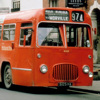Midland “Red” Motor Services (BMMO & MROC)
BMMO S16 — Overview
Introduction
Legislation passed in August 1961 increased the maximum length for single-deck buses and coaches used on British roads from 30′ 0″ to 36′ 0″, and maximum width from 8′ 0″ to 8′ 2½″. The Birmingham and Midland Motor Omnibus Company Limited (BMMO—Midland “Red” Motor Services) quickly took advantage of this potential increase in passenger capacity by introducing the BMMO S16, a 36′ 0″ version of the BMMO S14 with 7-bay construction and seating capacity of 52.
A prototype entered service in April 1962, followed by a batch of 50 vehicles from December 1962. A second batch of 34 vehicles entered service from January 1964, even though the BMMO S17 had already outdated the design at this time.
Note: For the younger generation…
For vehicle length, 30′ 0″ approximately equals 9m 14½cm, and 36′ 0″ approximately equals 10m 97¼cm.
For vehicle width, 8′ 0″ approximately equals 2m 43¾cm, and 8′ 2½″ approximately equals 2m 50cm.
Prototype
5095 (R/No: 5095HA)
Production of the prototype BMMO S16 started in 1961, shortly after the change in legislation regarding maximum vehicle size. BMMO gave the prototype the fleet number 5095, and it carried the registration number 5095HA. By April 1962, BMMO had completed production and initial testing, and the vehicle entered service at Cradley Heath depot for further testing. Later, the vehicle was also tested at Birmingham (Digbeth) depot, Bearwood depot, Sutton Coldfield depot and Nuneaton depot until September 1962, when she settled into normal service at Stafford depot.
5095 saw service several more depots, including a short time as engineering float allocation, before being withdrawn in October 1976 and scrapped.
Production Vehicles
5094, 5096–5144 (R/Nos: 5094HA, 5096–5144HA)
Production of the first batch of 50 BMMO S16 buses started in 1962, and deliveries to the depots started in December of that year, continuing until June 1963. Bodywork was finished either by BMMO or by Plaxton to BMMO design.
Although 5094 was numerically the first BMMO S16 from the batch, the vehicle was in reality built at the end of the batch and simply numbered out of sequence. Some believed that BMMO originally intended to use the registration number 5094HA, and thus the fleet number 5094, on an experimental vehicle such as the prototype BMMO S19 from 1964, which received the registration number 5093HA. However, it is more likely that BMMO cut production of the second batch of BMMO S15 Dual Purpose buses from 50 to 48 vehicles near the end of 1962, after the registration of first S16, thus leaving a gap in the numbering sequence which was filled by the S19 and this S16.
Between 1963 and 1967, almost a third of the vehicles from this batch were allocated to Worcester (Padmore Street) depot. The first ten examples arrived when new between January and April 1963, followed by another six examples coming from other depots in June 1963. In February 1964, the depot received an additional three vehicles from the second S16 batch, making a total allocation of 19 of the type at Worcester. It is likely that BMMO used the S16 in large numbers at Worcester because many parts of the city are inaccessible to double-deck buses due to low railway bridges and, with its increased length, the S16 would have provided increased passenger capacity without the expense of increasing service frequency. The arrival of fifteen DD12 Daimler Fleetline double-deck buses at the depot in May and November 1967 saw the type S16 allocation at Worcester reduced to 17 examples, but the majority remained at the depot into the 1970s, being replaced with the arrival of seventeen Leyland National type N1 and N2 single-deck buses in March and August 1973.
5512–5545 (R/Nos: 6512–6545HA)
By the mid-1963, shortcomings in the S16 design had already resulted in it being superseded by the BMMO S17, see Summary below for details. Nevertheless, BMMO produced a second batch of thirty-four BMMO S16 single-deck buses, which entered service between January and July 1964.
It is believed that BMMO had a quantity of unused 8.028-litre engines in stock at Central Works, and also a number of four-speed manual gearboxes had been made available from converting early BMMO C5 coaches to five-speed for motorway use. It is therefore probable that the second batch of S16s were assembled simply to use up parts which had become obsolete with the introduction of more advanced BMMO S17.
Summary
Unusually for Midland Red, the BMMO S16 was not a particularly successful vehicle design. The BMMO KL 8.028-litre engine, with a power output of only 98bhp, proved underpowered in a 36′ 0″, fifty-two seat bus and the David Brown manual “crash” gearbox was unpopular with drivers who had by now become familiar with the SCG semi-automatic gearboxes fitted to the BMMO D9 double-deck buses that were being built at that time. The S16 was also poorly suited for one-man operation and therefore was mostly used on crew operated routes.
These shortcomings lead to the S16 design quickly being replaced by the BMMO S17, and thus the type S16 became the last BMMO design to be fitted with a manual gearbox and the 8.028-litre version of the BMMO KL engine.
Despite their failings many examples of the S16, especially from the first batch, found other uses after withdrawal. The manual gearbox meant they were suited for driver training duties, and several ran for contractors Turriff, with two were also being used in service for Morris Pencoed.
Thankfully one example, fleet number 5545 (registration number 6545HA), from the second batch has survived and is preserved by Birmingham and Midland Motor Omnibus Trust (“The Transport Museum”—BaMMOT), Wythall. See the “BMMO S16 - Preserved” page for details.



